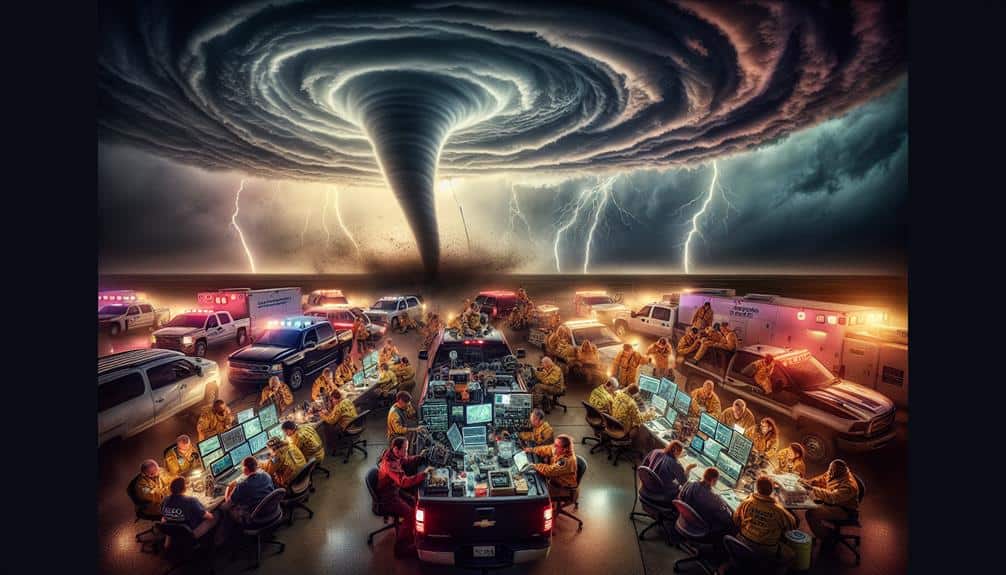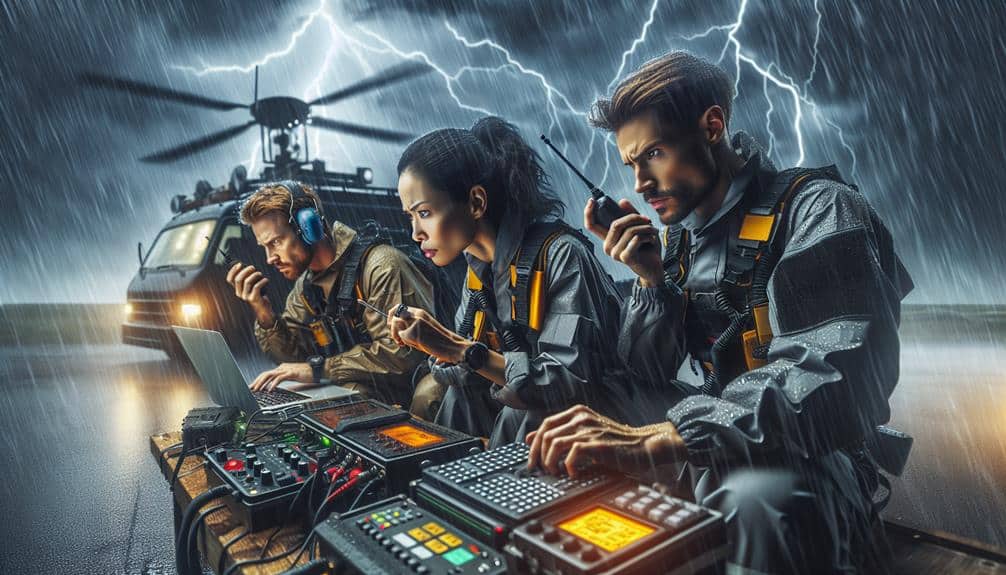We can optimize resources for efficient emergency response by tailoring our needs to specific situations and making sure essential materials are readily available. We should streamline communication with instant messaging and video conferencing tools, enabling rapid information sharing and seamless collaboration. Utilizing real-time data from various technologies helps us make quick, informed decisions. Regular training and preparedness drills guarantee our team's readiness, while ongoing evaluation of response effectiveness provides opportunities for continuous improvement. By tightening our resource allocation processes and maintaining situational awareness through live updates, we'll be better prepared for any emergency. Explore our strategies to enhance response coordination further.
Key Points
- Tailor resource needs based on specific types of emergencies for effective response.
- Ensure strategic availability of essential materials through regular inventory checks.
- Utilize real-time data and geolocation tracking for dynamic resource allocation.
- Integrate communication platforms to streamline information flow and enhance coordination.
Identifying Essential Resources
To effectively address emergency situations, we've got to pinpoint the critical resources that guarantee swift and efficient response actions. The key to resource allocation lies in identifying what's essential.
First, we've got to assess the types of emergencies we're most likely to face—natural disasters, medical crises, or industrial accidents—and tailor our resource needs accordingly.
Resource management isn't just about having enough supplies; it's about having the right ones in the right place at the right time. Our approach should be strategic, ensuring that essential materials like medical kits, food supplies, and temporary shelters are readily available. Additionally, we need trained personnel who can act decisively under pressure.
We must also consider logistical support—vehicles, fuel, and communication tools are crucial for coordinating efforts and reaching affected areas swiftly. By mapping out potential scenarios and conducting regular inventory checks, we can ensure resources are always prepared for immediate deployment.
Ultimately, our goal is freedom from chaos and inefficiency during emergencies. By meticulously managing our resources and allocating them wisely, we can create an agile response system that saves lives and restores order quickly. This strategic approach empowers us to handle emergencies with confidence and precision.
Implementing Real-Time Communication
As we move forward, implementing real-time communication stands essential for boosting our emergency response efficiency.
By ensuring rapid information sharing, we can facilitate seamless team collaboration and provide instant status updates.
This approach will enable us to make swift, informed decisions during critical moments.
Rapid Information Sharing
Leveraging instant communication tools allows us to share crucial information rapidly, ensuring a coordinated and efficient emergency response. By implementing data encryption, we can guarantee that all shared data remains secure, maintaining the integrity and confidentiality of sensitive information. Establishing robust response protocols helps us to standardize our approach, making it easier to quickly disseminate essential information to all relevant parties.
Using geolocation tracking, we can monitor the exact location of our resources and personnel in real time. This capability allows us to allocate assets more efficiently, guaranteeing that the right resources are available exactly where and when they're needed. Accurate geolocation data paired with resource availability insights enables us to adapt dynamically to changing situations, enhancing our responsiveness during emergencies.
Furthermore, integrating these technologies into our communication framework empowers us to make informed decisions swiftly. Real-time data sharing allows for immediate updates and adjustments to strategies, minimizing delays that could impact the outcome of our response efforts. Essentially, the strategic implementation of real-time communication tools and protocols not only optimizes resource allocation but also fosters a more agile and effective emergency response system.
Seamless Team Collaboration
Effective team collaboration depends on the implementation of real-time communication tools that enable us to synchronize our efforts seamlessly during emergency responses. By leveraging these tools, we can guarantee that our team dynamics remain strong and adaptable, regardless of the situation's complexity.
Strategically, real-time communication enhances our ability to execute well-coordinated actions, minimizing delays and misunderstandings. When every member of our team has instant access to critical information, we can make faster, more informed decisions. This agility is essential in emergency scenarios, where every second counts.
To optimize our communication strategies, we should adopt platforms that support instant messaging, video conferencing, and integrated data sharing. These tools help us maintain a constant flow of information and facilitate quick, collaborative problem-solving. Additionally, fostering an environment where every team member feels encouraged to share insights and updates can further strengthen our collective responsiveness.
Moreover, we must regularly train and drill our teams on these communication tools to guarantee proficiency under pressure. By doing so, we not only improve our immediate responses but also build a resilient team capable of adapting to evolving challenges.
Ultimately, seamless team collaboration through real-time communication is a cornerstone of effective emergency response coordination.
Instant Status Updates
Our ability to maintain seamless team collaboration hinges on implementing instant status updates, ensuring every team member stays informed in real-time. By leveraging emergency notifications and response tracking systems, we can achieve unparalleled situational awareness. This approach allows us to deliver critical updates instantly, minimizing delays and maximizing the efficiency of our emergency response.
Real-time communication tools are the backbone of our strategy. They enable us to disseminate emergency notifications as events unfold, ensuring that no one is left in the dark. When every second counts, having the most current information at our fingertips empowers us to make informed decisions quickly. We can track the progress of our responses, adjusting our strategies dynamically based on the latest critical updates.
Moreover, real-time status updates foster a culture of transparency and accountability. Everyone on our team knows what's happening and can see their role in the bigger picture. This situational awareness not only boosts individual performance but also enhances collective coordination. We're not just responding to emergencies; we're proactively managing them.
In the ever-evolving landscape of emergency response, instant status updates aren't a luxury—they're a necessity for maintaining freedom and control.
Leveraging Technology Tools

To improve our emergency response efforts, we need to leverage technology tools that provide real-time data and integrate communication platforms.
By utilizing real-time data, we can make informed decisions more quickly and efficiently.
Integrating various communication platforms guarantees seamless coordination among all responders.
Real-Time Data Utilization
Leveraging real-time data through advanced technology tools allows us to make informed decisions quickly during emergency response operations. By integrating data analysis into our response coordination efforts, we can identify vital patterns and trends that inform our resource allocation and tactical decisions. This strategic approach not only enhances our efficiency but also empowers us to act swiftly and decisively, minimizing the impact of emergencies.
When we utilize real-time data, we can dynamically adjust our strategies based on the evolving situation on the ground. For instance, live feeds from drones and satellites can provide us with an accurate assessment of affected areas, allowing us to deploy aid where it's most needed. By continuously analyzing this data, we can forecast potential developments and proactively address emerging threats.
Moreover, real-time data utilization fosters a collaborative environment where all stakeholders have access to the same information. This transparency guarantees that everyone is on the same page, leading to more cohesive and effective response efforts.
In an age where information is power, our ability to harness real-time data through advanced technology tools is essential for optimizing emergency response and achieving the freedom to operate with agility and precision.
Communication Platforms Integration
Integrating diverse communication platforms allows us to streamline information flow and enhance coordination during emergency response operations. By securing platform compatibility and efficient data integration, we can break down silos and facilitate seamless interactions between different agencies and responders. This not only speeds up decision-making but also minimizes the risk of miscommunication in high-stress situations.
To achieve this, we must focus on developing interoperable systems that can communicate using standardized messaging protocols. Interoperable systems allow various platforms, from radio networks to digital communication tools, to exchange information effortlessly. By adopting such systems, we guarantee that all stakeholders, including first responders, medical teams, and command centers, can access and share essential data in real-time.
Moreover, integrating these communication platforms isn't just about technology; it's about strategy. We need to conduct thorough assessments of existing systems to identify gaps and opportunities for improvement. Training programs should be implemented to make certain that personnel are proficient in using these integrated tools.
This holistic approach ensures that our emergency response efforts aren't only technologically advanced but also strategically sound, enabling us to provide the swift and effective response that our communities deserve.
Training and Preparedness Drills
Effective training and preparedness drills are the backbone of a well-coordinated emergency response system. By engaging in scenario simulations and hands-on practice, we can guarantee our teams are ready to tackle real-world crises.
Scenario simulations allow us to create realistic and diverse emergency situations, enabling responders to experience a wide range of potential events. This immersive approach helps pinpoint weaknesses in our procedures and fortifies our overall readiness.
Hands-on practice is essential for reinforcing the skills needed in high-pressure situations. When we train in a controlled environment, we not only build individual competence but also enhance team cohesion. Coordinated efforts during these drills translate directly into more effective and efficient real-world responses.
Team debriefings and feedback sessions following each drill are vital for continuous improvement. These discussions allow us to analyze performance, identify areas for enhancement, and implement necessary changes. By fostering an environment where feedback is valued and acted upon, we drive our teams towards excellence.
Training and preparedness drills aren't just about going through the motions; they're strategic investments in our capability to respond swiftly and effectively. Let's prioritize these drills to guarantee we're always one step ahead in managing emergencies.
Streamlining Resource Allocation

To respond promptly to emergencies, we need to streamline our resource allocation processes meticulously. By optimizing our resources, we can enhance coordination efficiency, ensuring that we deploy the right assets at the right time. Resource optimization is key; it allows us to minimize waste and maximize impact.
To achieve this, we should focus on:
- Real-time data integration: Leveraging technology to consolidate data from various sources ensures we've a holistic view of resource availability and needs.
- Decentralized decision-making: Empowering local teams with the authority to allocate resources quickly based on real-time intelligence.
- Dynamic resource mapping: Continuously updating resource locations and statuses to adapt to rapidly changing situations.
- Prioritization protocols: Establishing clear criteria for resource allocation based on urgency, impact, and availability.
Evaluating Response Effectiveness
Once we've optimized our resource allocation, we must thoroughly evaluate our response effectiveness to ensure continuous improvement and preparedness. It's vital to employ a systematic approach to response evaluation, ensuring that every action taken during an emergency is scrutinized for its impact and efficiency. This means collecting data on key performance metrics such as response time, resource utilization, and incident resolution outcomes.
By analyzing this data, we can identify strengths and weaknesses in our current strategies. Are we deploying resources where they're needed most? Are there gaps in our response that could be filled with better training or additional equipment? These questions form the backbone of our evaluation process.
Equally important is the feedback loop. We need to gather insights from everyone involved, from first responders to community members affected by our actions. Their perspectives provide invaluable information that can't be captured by metrics alone.
Incorporating these findings, we can adjust our resource allocation models to be more dynamic and adaptive. This continuous cycle of evaluation and adjustment not only enhances our immediate response capabilities but also builds a resilient framework for future emergencies. By committing to this thorough evaluation process, we empower ourselves to act swiftly and effectively in any crisis.
Frequently Asked Questions
How Do You Ensure Community Involvement in Emergency Response Planning?
For effective community engagement, we start by seeking strong, supportive stakeholders. We streamline volunteer recruitment through strategic outreach, ensuring everyone's empowered and involved in emergency response planning. Together, we create a coordinated, resilient, and responsive community.
What Are the Legal Considerations in Emergency Resource Management?
When addressing legal considerations in emergency resource management, we must comply with legal regulations and guarantee equitable resource allocation. We strategically navigate these laws to maintain community trust and maximize our freedom in emergency response efforts.
How Can We Secure Funding for Advanced Emergency Response Technologies?
To secure funding for advanced emergency response technologies, we should explore diverse funding sources, diligently prepare grant applications, and cultivate public-private partnerships and corporate sponsorships. This strategic approach guarantees financial freedom and resource optimization.
What Are the Best Practices for Inter-Agency Collaboration During Emergencies?
To improve inter-agency collaboration during emergencies, we should establish clear communication protocols and conduct regular training exercises. These steps guarantee swift, coordinated responses, empowering us to act decisively and maintain our freedom to protect communities.
How Do You Address the Mental Health of Responders Post-Emergency?
We address responders' mental health by providing trauma support and resilience training. These strategies help build a robust support network, promoting recovery and long-term well-being, ensuring they're ready for future emergencies.


